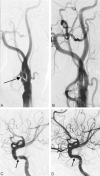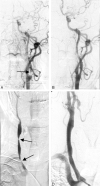Concomitant multiple revascularizations in supra-aortic arteries: short-term results in 50 patients
- PMID: 17921235
- PMCID: PMC8134272
- DOI: 10.3174/ajnr.A0706
Concomitant multiple revascularizations in supra-aortic arteries: short-term results in 50 patients
Abstract
Background and purpose: The outcome for simultaneous revascularization of more than 1 supra-aortic arterial stenosis has not been evaluated because of concerns regarding the increased risk of additional procedures. We evaluated the feasibility and safety of concomitant multiple supra-aortic arterial revascularizations (CMSAR).
Materials and methods: We retrospectively evaluated 50 consecutive patients who underwent CMSARs with angioplasty and stent placement. The study included a separate lesion group (LG) (n = 28), ipsilateral LG (n = 17) including adjacent (n = 6) and remote (n = 11) tandem lesions, and triple LG (n = 5). We assessed the procedural success (defined as residual stenosis <30%) and periprocedural event rate (ER) (minor or major stroke, and death). We compared the ERs in the lesion (ipsilateral vs separate) and symptom (unstable vs stable) pattern groups with the Fisher exact test.
Results: Procedural success was achieved in all patients (50/50). Periprocedural events within 30 days were noted in 5 (10%). ER within 2 days after the procedure was higher in the ipsilateral LG (4/17) than in the separate LG (0/28) (P = .016). Major events consisting of a major stroke and a death occurred in 2 patients in the unstable group (4%) and was more common in the unstable (2 of 7) than in the stable group (0/38) (P = .029). During the mean 11-month follow-up period, there was 1 symptomatic recurrence.
Conclusion: CMSARs are feasible with a high procedural success rate resulting in a favorable short-term outcome. However, they must be carefully performed in ipsilateral LG, especially in patients in the unstable group.
Figures



Similar articles
-
A 7-year experience with balloon-mounted coronary stents for the treatment of symptomatic vertebrobasilar intracranial atheromatous disease.Neurosurgery. 2007 Aug;61(2):236-42; discussion 242-3. doi: 10.1227/01.NEU.0000255521.42579.31. Neurosurgery. 2007. PMID: 17762735
-
[Percutaneous transluminal dilatation (PTD) of descending stenoses of the vertebral artery].Zentralbl Chir. 1986;111(12):709-16. Zentralbl Chir. 1986. PMID: 2944326 German.
-
Stent design lowers angiographic but not clinical adverse events in stenting of symptomatic intracranial stenosis - results of a single center study with 100 consecutive patients.Int J Stroke. 2013 Feb;8(2):87-94. doi: 10.1111/j.1747-4949.2011.00715.x. Epub 2012 Feb 1. Int J Stroke. 2013. PMID: 22296983
-
Use of stents to treat intracranial cerebrovascular disease.Annu Rev Med. 2007;58:107-22. doi: 10.1146/annurev.med.58.121205.100631. Annu Rev Med. 2007. PMID: 17217328 Review.
-
Percutaneous intervention for posterior fossa ischemia. A single center experience and review of the literature.Int J Cardiol. 2008 Jun 23;127(1):70-7. doi: 10.1016/j.ijcard.2007.05.006. Epub 2007 Jul 24. Int J Cardiol. 2008. PMID: 17651834 Review.
Cited by
-
The Use of Protection Device in Landmark-wire Technique of Symptomatic Subclavian Artery Occlusion with Combined Approach via Trans-femoral vs. Trans-brachial Arteries: Technical note.Neurointervention. 2011 Aug;6(2):89-94. doi: 10.5469/neuroint.2011.6.2.89. Epub 2011 Aug 31. Neurointervention. 2011. PMID: 22125755 Free PMC article.
-
A Study Design to Evaluate Association between Smoking and Intracranial Atherosclerotic Stenosis.Neurointervention. 2014 Sep;9(2):89-93. doi: 10.5469/neuroint.2014.9.2.89. Epub 2014 Sep 3. Neurointervention. 2014. PMID: 25426304 Free PMC article.
-
Long-term Outcomes of Drug-eluting Stents in Symptomatic Intracranial Stenosis.Neurointervention. 2013 Feb;8(1):9-14. doi: 10.5469/neuroint.2013.8.1.9. Epub 2013 Feb 28. Neurointervention. 2013. PMID: 23515851 Free PMC article.
-
Intracranial stenting for severe symptomatic stenosis: self-expandable versus balloon-expandable stents.Interv Neuroradiol. 2013 Sep;19(3):276-82. doi: 10.1177/159101991301900303. Epub 2013 Sep 26. Interv Neuroradiol. 2013. PMID: 24070075 Free PMC article.
-
Outcome evaluation of carotid stenting in high-risk patients with symptomatic carotid near occlusion.Interv Neuroradiol. 2010 Sep;16(3):309-16. doi: 10.1177/159101991001600314. Epub 2010 Oct 25. Interv Neuroradiol. 2010. PMID: 20977866 Free PMC article.
References
-
- Yadav JS, Roubin GS, Iyer S, et al. Elective stenting of the extracranial carotid arteries. Circulation 1997;95:376–81 - PubMed
-
- Shawl F, Kadro W, Domanski MJ, et al. Safety and efficacy of elective carotid artery stenting in high-risk patients. J Am Coll Cardiol 2000;35:1721–28 - PubMed
-
- Mathur A, Roubin GS, Iyer SS, et al. Predictors of stroke complicating carotid artery stenting. Circulation 1998;97:1239–45 - PubMed
-
- Roubin GS, New G, Iyer SS, et al. Immediate and late clinical outcomes of carotid artery stenting in patients with symptomatic and asymptomatic carotid artery stenosis: a 5-year prospective analysis. Circulation 2001;103:532–37 - PubMed
-
- O'Leary DH, Polak JF, Kronmal RA, et al. Carotid-artery intima and media thickness as a risk factor for myocardial infarction and stroke in older adults. Cardiovascular Health Study Collaborative Research Group. N Engl J Med 1999;340:14–22 - PubMed
MeSH terms
LinkOut - more resources
Full Text Sources
Medical
